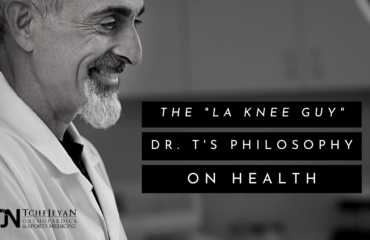The patella, commonly called the kneecap, is part of the knee joint. Like all bones, it can get injured or fractured due to overuse, injury, or as a result of weakening from osteoporosis. The type of treatment required and the time it takes to heal a patella injury depends on whether it is simply cracked or whether it has broken into several pieces.
A simple patellar fracture, where the bone pieces have cracked but stayed in place, usually does not usually require surgery. While it needs to be given time to heal, patients might be able to start walking and exercising again after six to eight weeks.
However, an injury that includes the displacement of the broken bone pieces or the bone pieces protruding through the skin usually requires surgery. For a surgical repair, it may take three to six months until the patient can participate in normal activities.
What Happens at the Doctor’s Office?
At Tchejeyan Orthopaedics and Sports Medicine, when a patient comes in with a painful or displaced kneecap, the first step we take is to carefully examine the knee, both manually and through imaging methods such as X-rays and scans. The imaging will indicate whether or not surgery is warranted or advised. Based on what the imaging shows, the doctor may offer one of several options.
Non-invasive Treatments
If the injury does not require surgery, the first step in any healing process will be to take the weight off the leg to give the patella time to heal. In addition, the patella should be iced at regular intervals to reduce swelling and elevated it whenever possible. Whether or not a patient will be allowed to walk or put any weight on the knee will depend upon the nature of the injury. In most cases, a patient will also need to take over-the-counter or prescription pain medications while the patella is healing.
Surgery
If the patella is fractured such that the broken parts of the bone have been displaced, surgery will be necessary, because the pieces will not set correctly together on their own. Dr. Tchejeyan uses screws, plates, wires, or pins to reconnect the fragments. In some cases, he may also have to re-attach tendons to the bone. Most patella surgeries can be performed with a local anesthetic, but it depends on the severity of the patient’s condition.
Rehabilitation
Almost every patient with a patellar fracture needs rehabilitation for several months after the bone has healed. Because rest and knee immobility will be required for several weeks, physical therapy will be necessary following healing. When a patient is immobile, the muscles, tendons, and ligaments become stiff and weak. With physical therapy, the leg and knee will become accustomed to movement again and will rebuild strength and flexibility.
How to Improve the Prognosis
Most people heal completely from a patellar fracture, but if the bone fragments don’t grow back together properly, long-term consequences like pain and limited range of motion are possible. Consequently, it is important to follow all doctor’s orders and make sure that the knee is completely healed before resuming exercise. It is also important to wear a knee brace during rehabilitation to prevent re-injury.
If you think or know you may have a fractured patella, seek medical help right away. While healing from a patellar fracture may involve treatment that has an extended recovery time, failure to obtain the right remedy can result in serious long-term problems. Call Tchejeyan Orthopaedics and Sports Medicine today and book a diagnostic appointment.



